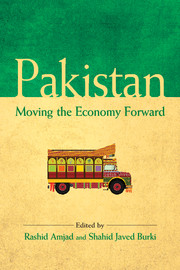Book contents
- Frontmatter
- Contents
- List of figures and tables
- Preface
- 1 Overview
- 2 Failed Economic Promise: Lessons from Pakistan's Development Experience
- 3 Economic Management Under IMF Tutelage: Key Lessons from the Musharraf and PPP Rule 1999–2013
- 4 A Country and an Economy in Transition
- 5 Tackling the Energy Crisis
- 6 Exports: Lessons from the Past and the Way Forward
- 7 The Future Path of Tax Reforms in Pakistan
- 8 Pakistan's Indus Basin Water Strategy: Past, Present and Future
- 9 Economic Governance and Institutional Reforms
- 10 Benefiting from Foreign Direct Investment
- 11 An Analysis of the Remittances Market in Pakistan
- 12 The Prospects for Indo-Pakistan Trade
- 13 Beyond the Poverty Line: A Multidimensional Analysis of Poverty in Pakistan
- 14 Can the New Intergovernmental Structure Work in Pakistan? Learning from China
- Contributors
- Index
1 - Overview
Published online by Cambridge University Press: 05 May 2015
- Frontmatter
- Contents
- List of figures and tables
- Preface
- 1 Overview
- 2 Failed Economic Promise: Lessons from Pakistan's Development Experience
- 3 Economic Management Under IMF Tutelage: Key Lessons from the Musharraf and PPP Rule 1999–2013
- 4 A Country and an Economy in Transition
- 5 Tackling the Energy Crisis
- 6 Exports: Lessons from the Past and the Way Forward
- 7 The Future Path of Tax Reforms in Pakistan
- 8 Pakistan's Indus Basin Water Strategy: Past, Present and Future
- 9 Economic Governance and Institutional Reforms
- 10 Benefiting from Foreign Direct Investment
- 11 An Analysis of the Remittances Market in Pakistan
- 12 The Prospects for Indo-Pakistan Trade
- 13 Beyond the Poverty Line: A Multidimensional Analysis of Poverty in Pakistan
- 14 Can the New Intergovernmental Structure Work in Pakistan? Learning from China
- Contributors
- Index
Summary
The central question that the contributors to this volume seek to answer is how to reverse the current prolonged period of low growth and high inflation—stagflation—that Pakistan has experienced over the past five years, and to suggest and implement measures that would decisively move the economy onto a higher, more sustainable growth path. Eight key messages emerge from the studies presented in this volume:
– There is an urgent need to revive investment, which has fallen dismally to 12.5 per cent of gross domestic product (GDP) in 2011/12 from its peak of 22.5 per cent in 2006/07. This could be done by improving the investment climate and removing binding constraints—especially in energy—on new domestic and foreign investment. Pakistan needs to increase its investment-to-GDP ratio to over 30 per cent over the next decade if it is to generate sufficient employment to productively employ its fast-growing labor force and compete effectively with other rapidly growing developing countries. However, in the medium term, investment may continue to be constrained by resource availability and so, in the near future, a large part of the revival of growth will have to come from exploiting unused capacity and productivity gains.
– Pakistan's economic problems are structural and not just cyclical. Deep economic reforms are needed to remove structural imbalances to increase efficiency and competitiveness, and to spur entrepreneurship and innovation in the economy. Undertaking these reforms will require political will and a carefully sequenced pace of critical reforms so as to ease the burden of adjustment.
– The binding constraints to Pakistan's growth need to be overcome to revive the economy and ensure sustainable growth. These include tackling the crippling energy shortage, increasing revenues to regain macroeconomic stability and reduce the current unsustainable fiscal deficit, and ensuring the availability of water to meet the needs of the agricultural economy.
– Exports should be made a major driver of economic growth. This will mean reversing Pakistan's past poor performance in integrating with global markets—reflected in the country's stagnant share in global exports.
- Type
- Chapter
- Information
- PakistanMoving the Economy Forward, pp. 1 - 21Publisher: Cambridge University PressPrint publication year: 2015
- 1
- Cited by



